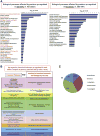Development of a protein marker panel for characterization of human induced pluripotent stem cells (hiPSCs) using global quantitative proteome analysis
- PMID: 25840413
- PMCID: PMC5778352
- DOI: 10.1016/j.scr.2015.01.009
Development of a protein marker panel for characterization of human induced pluripotent stem cells (hiPSCs) using global quantitative proteome analysis
Abstract
The emergence of new methods for reprogramming of adult somatic cells into induced pluripotent stem cells (iPSC) led to the development of new approaches in drug discovery and regenerative medicine. Investigation of the molecular mechanisms underlying the self-renewal, expansion and differentiation of human iPSC (hiPSC) should lead to improvements in the manufacture of safe and reliable cell therapy products. The goal of our study was qualitative and quantitative proteomic characterizations of hiPSC by means of electrospray ionization (ESI)-MS(e) and MALDI-TOF/TOF mass spectrometry (MS). Proteomes of hiPSCs of different somatic origins: fibroblasts and peripheral blood CD34(+) cells, reprogrammed by the same technique, were compared with the original somatic cells and hESC. Quantitative proteomic comparison revealed approximately 220 proteins commonly up-regulated in all three pluripotent stem cell lines compared to the primary cells. Expression of 21 proteins previously reported as pluripotency markers was up-regulated in both hiPSCs (8 were confirmed by Western blot). A number of novel candidate marker proteins with the highest fold-change difference between hiPSCs/hESC and somatic cells discovered by MS were confirmed by Western blot. A panel of 22 candidate marker proteins of hiPSC was developed and expression of these proteins was confirmed in 8 additional hiPSC lines.
Published by Elsevier B.V.
Conflict of interest statement
There is no conflict of interest for any author to report.
Figures





Similar articles
-
Mass cytometry-based single-cell analysis of human stem cell reprogramming uncovers differential regulation of specific pluripotency markers.J Biol Chem. 2019 Dec 6;294(49):18547-18556. doi: 10.1074/jbc.RA119.009061. Epub 2019 Sep 30. J Biol Chem. 2019. PMID: 31570522 Free PMC article.
-
Proteomic and functional comparison between human induced and embryonic stem cells.Elife. 2024 Nov 14;13:RP92025. doi: 10.7554/eLife.92025. Elife. 2024. PMID: 39540879 Free PMC article.
-
Comparative proteomic analysis of human somatic cells, induced pluripotent stem cells, and embryonic stem cells.Stem Cells Dev. 2012 May 20;21(8):1272-86. doi: 10.1089/scd.2011.0243. Epub 2011 Aug 29. Stem Cells Dev. 2012. PMID: 21787230
-
Comparative study of human-induced pluripotent stem cells derived from bone marrow cells, hair keratinocytes, and skin fibroblasts.Eur Heart J. 2013 Sep;34(33):2618-29. doi: 10.1093/eurheartj/ehs203. Epub 2012 Jul 12. Eur Heart J. 2013. PMID: 22798560
-
MicroRNA regulation of endothelial homeostasis and commitment-implications for vascular regeneration strategies using stem cell therapies.Free Radic Biol Med. 2013 Sep;64:52-60. doi: 10.1016/j.freeradbiomed.2013.04.037. Epub 2013 May 9. Free Radic Biol Med. 2013. PMID: 23665307 Review.
Cited by
-
The quest of cell surface markers for stem cell therapy.Cell Mol Life Sci. 2021 Jan;78(2):469-495. doi: 10.1007/s00018-020-03602-y. Epub 2020 Jul 24. Cell Mol Life Sci. 2021. PMID: 32710154 Free PMC article. Review.
-
Potassium as a pluripotency-associated element identified through inorganic element profiling in human pluripotent stem cells.Sci Rep. 2017 Jul 10;7(1):5005. doi: 10.1038/s41598-017-05117-2. Sci Rep. 2017. PMID: 28694442 Free PMC article.
-
Differentiation of human and murine induced pluripotent stem cells to microglia-like cells.Nat Neurosci. 2017 May;20(5):753-759. doi: 10.1038/nn.4534. Epub 2017 Mar 2. Nat Neurosci. 2017. PMID: 28253233 Free PMC article.
-
Proteomics applications in next generation induced pluripotent stem cell models.Expert Rev Proteomics. 2024 Apr;21(4):217-228. doi: 10.1080/14789450.2024.2334033. Epub 2024 Mar 27. Expert Rev Proteomics. 2024. PMID: 38511670 Free PMC article. Review.
-
Genotyping, generation and proteomic profiling of the first human autosomal dominant osteopetrosis type II-specific induced pluripotent stem cells.Stem Cell Res Ther. 2019 Aug 14;10(1):251. doi: 10.1186/s13287-019-1369-8. Stem Cell Res Ther. 2019. PMID: 31412925 Free PMC article.
References
-
- Bachy I, Franck MC, Li L, Abdo H, Pattyn A, Ernfors P. The transcription factor Cux2 marks development of an A-delta sublineage of TrkA sensory neurons. Dev. Biol. 2011;360:77–86. - PubMed
-
- Bar-Nur O, Russ HA, Efrat S, Benvenisty N. Epigenetic memory and preferential lineage-specific differentiation in induced pluripotent stem cells derived from human pancreatic islet beta cells. Cell Stem Cell. 2011;9:17–23. - PubMed
-
- Benevento M, Munoz J. Role of mass spectrometry-based proteomics in the study of cellular reprogramming and induced pluripotent stem cells. Expert Rev. Proteomics. 2012;9:379–399. - PubMed
-
- Bodnar WM, Blackburn RK, Krise JM, Moseley MA. Exploiting the complementary nature of LC/MALDI/MS/MS and LC/ESI/MS/MS for increased proteome coverage. J. Am. Soc. Mass Spectrom. 2003;14(9):971–979. - PubMed
MeSH terms
Substances
Grants and funding
LinkOut - more resources
Full Text Sources
Other Literature Sources

